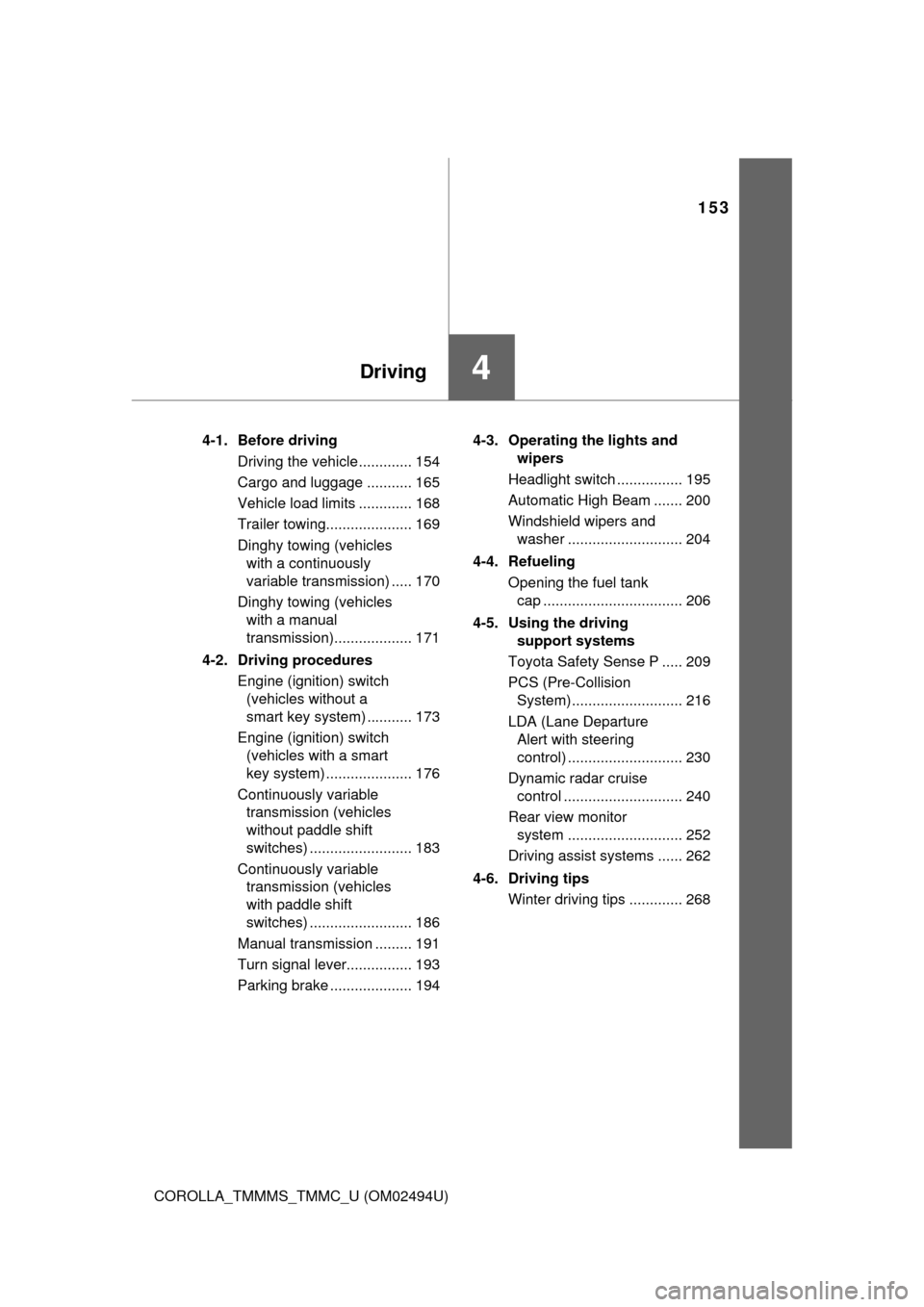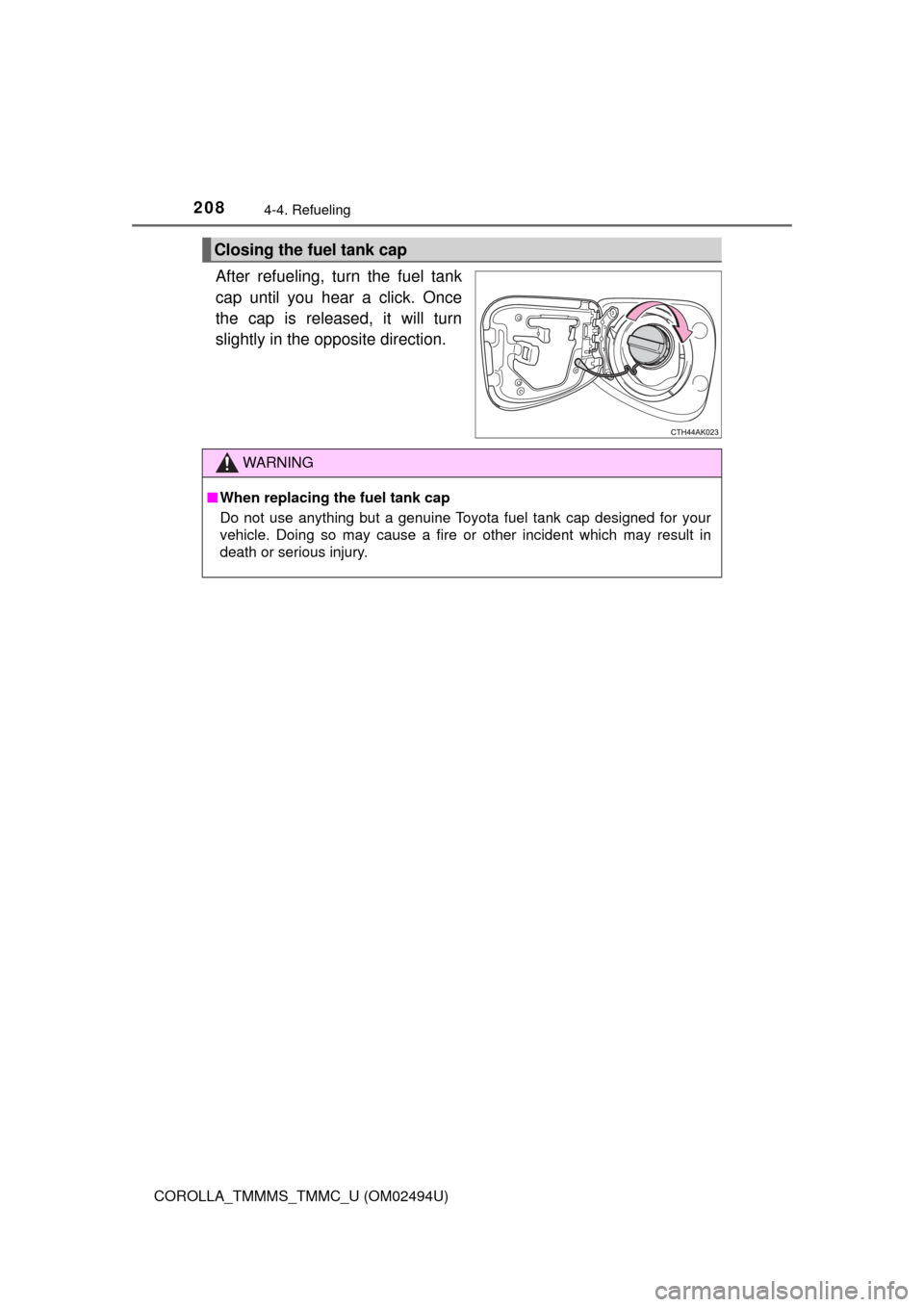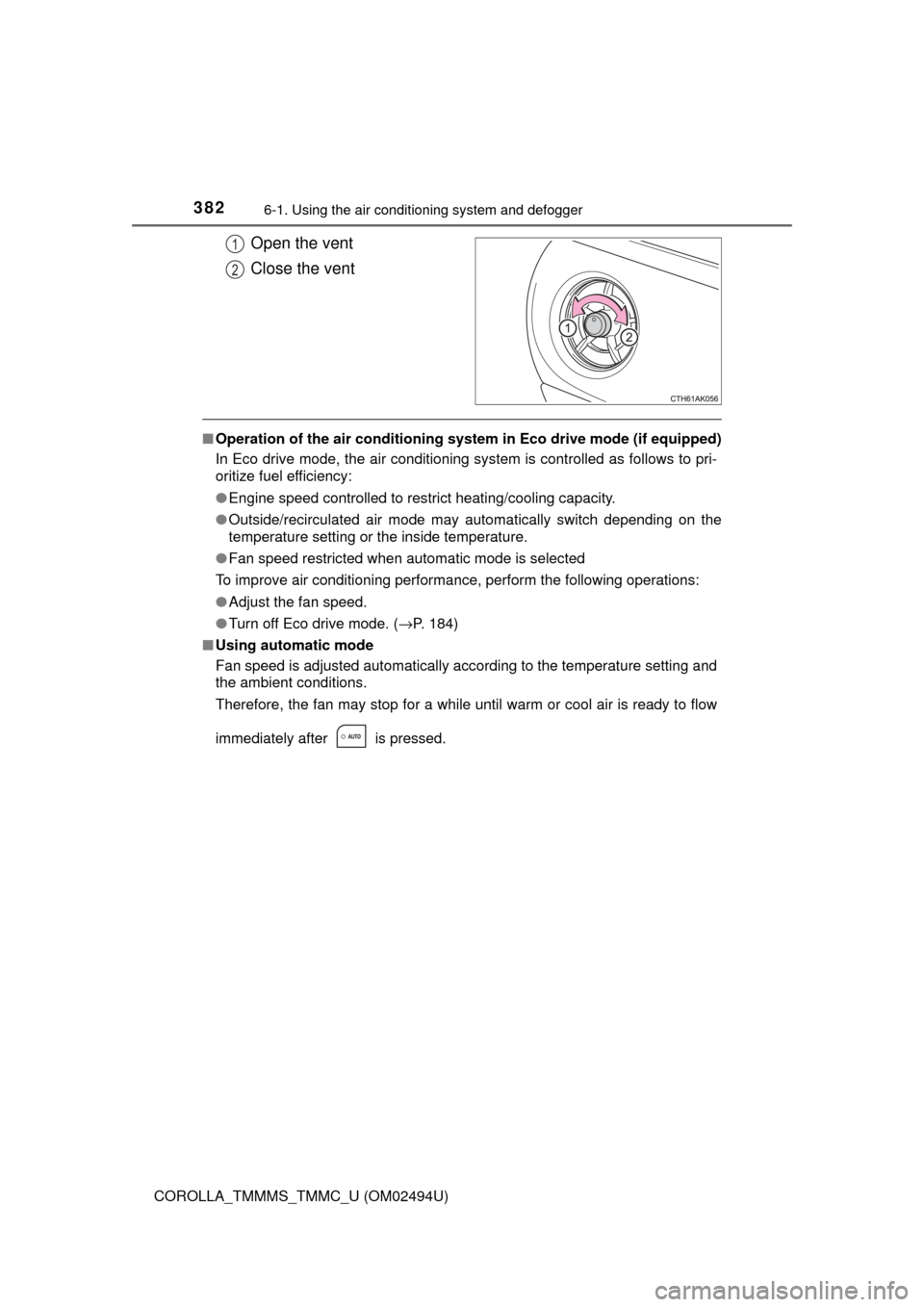2017 TOYOTA COROLLA fuel cap
[x] Cancel search: fuel capPage 4 of 612

TABLE OF CONTENTS4
COROLLA_TMMMS_TMMC_U (OM02494U)4-4. Refueling
Opening the fuel tank
cap .................................. 206
4-5. Using the driving
support systems
Toyota Safety Sense P ..... 209
PCS
(Pre-Collision System) .... 216
LDA (Lane Departure
Alert with steering
control) ............................ 230
Dynamic radar cruise
control ............................. 240
Rear view monitor
system............................. 252
Driving assist systems....... 262
4-6. Driving tips
Winter driving tips.............. 268
5-1. Basic Operations
Audio system types ........... 274
Steering wheel audio
switches .......................... 275
AUX port/USB port ............ 276
Entune Audio..................... 277
Basic audio operations ...... 280
5-2. Setup
Setup menu ....................... 282
General settings ................ 283
Audio settings.................... 285
Display settings ................. 286
Voice settings .................... 2875-3. Using Entune Audio
Selecting the audio
source.............................. 288
List screen operation ......... 289
Optimal use of Entune
Audio ............................... 291
5-4. Using the radio
Radio operation ................. 292
5-5. Playing an audio CD and
MP3/WMA/AAC discs
CD player operation........... 294
5-6. Using an external
device
Listening to an iPod ........... 300
Listening to a USB
memory device ................ 305
Using the AUX port ............ 309
5-7. Connecting Bluetooth
®
Preparations to
use wireless
communication ................ 310
Registering a Bluetooth
®
audio player for the
first time ........................... 314
Registering a Bluetooth
®
phone for the first time..... 315
Registering a Bluetooth
®
device .............................. 316
Connecting a Bluetooth
®
device .............................. 319
Displaying a Bluetooth
®
device details................... 322
Detailed Bluetooth
®
system settings................ 323
5Audio system
Page 15 of 612

15Pictorial index
COROLLA_TMMMS_TMMC_U (OM02494U)Windshield wipers . . . . . . . . . . . . . . . . . . . . . . . . . . . . . . . . . P. 204
Precautions against winter season . . . . . . . . . . . . . . . . . . . . . P. 268
To prevent freezing (windshield wiper de-icer)
* . . . . . . . . . . . P. 380
Fuel filler door . . . . . . . . . . . . . . . . . . . . . . . . . . . . . . . . . . . . P. 206
Refueling method . . . . . . . . . . . . . . . . . . . . . . . . . . . . . . . . . . . P. 206
Fuel type/fuel tank capacity . . . . . . . . . . . . . . . . . . . . . . . . . . . P. 544
Tires . . . . . . . . . . . . . . . . . . . . . . . . . . . . . . . . . . . . . . . . . . P. 444
Tire size/inflation pressure . . . . . . . . . . . . . . . . . . . . . . . . . P. 550
Winter tires/tire chain . . . . . . . . . . . . . . . . . . . . . . . . . . . . . P. 268
Checking/rotation/tire pressure warning system
*. . . . . . . . P. 444
Coping with flat tires . . . . . . . . . . . . . . . . . . . . . . . . . . . . . . P. 513
Hood . . . . . . . . . . . . . . . . . . . . . . . . . . . . . . . . . . . . . . . . . . . . P. 429
Opening . . . . . . . . . . . . . . . . . . . . . . . . . . . . . . . . . . . . . . . . . . P. 429
Engine oil . . . . . . . . . . . . . . . . . . . . . . . . . . . . . . . . . . . . . . . . . P. 544
Coping with overheat . . . . . . . . . . . . . . . . . . . . . . . . . . . . . . . . P. 535
Headlights/daytime running lights
*. . . . . . . . . . . . . . . . . . . P. 195
Front turn signal/parking lights . . . . . . . . . . . . . . . . . . . . . . P. 195
Daytime running lights
* . . . . . . . . . . . . . . . . . . . . . . . . . . . . P. 195
Front side marker lights . . . . . . . . . . . . . . . . . . . . . . . . . . . . P. 195
Turn signal lights
*. . . . . . . . . . . . . . . . . . . . . . . . . . . . . . . . . P. 193
Stop/tail lights/rear side marker lights . . . . . . . . . . . . . . . . P. 195
Back-up lights
Shifting the shift lever to R . . . . . . . . . . . . . . . . . . . . P. 183, 186, 191
License plate lights . . . . . . . . . . . . . . . . . . . . . . . . . . . . . . . . P. 195
4
5
6
7
Light bulbs of the exterior lights for driving
(Replacing method: P. 465, Watts: P. 551)
*: If equipped
8
9
10
11
12
13
14
15
Page 153 of 612

153
4Driving
COROLLA_TMMMS_TMMC_U (OM02494U)4-1. Before driving
Driving the vehicle ............. 154
Cargo and luggage ........... 165
Vehicle load limits ............. 168
Trailer towing..................... 169
Dinghy towing (vehicles
with a continuously
variable transmission) ..... 170
Dinghy towing (vehicles
with a manual
transmission)................... 171
4-2. Driving procedures
Engine (ignition) switch
(vehicles without a
smart key system) ........... 173
Engine (ignition) switch
(vehicles with a smart
key system) ..................... 176
Continuously variable
transmission (vehicles
without paddle shift
switches) ......................... 183
Continuously variable
transmission (vehicles
with paddle shift
switches) ......................... 186
Manual transmission ......... 191
Turn signal lever................ 193
Parking brake .................... 1944-3. Operating the lights and
wipers
Headlight switch ................ 195
Automatic High Beam ....... 200
Windshield wipers and
washer ............................ 204
4-4. Refueling
Opening the fuel tank
cap .................................. 206
4-5. Using the driving
support systems
Toyota Safety Sense P ..... 209
PCS (Pre-Collision
System)........................... 216
LDA (Lane Departure
Alert with steering
control) ............................ 230
Dynamic radar cruise
control ............................. 240
Rear view monitor
system ............................ 252
Driving assist systems ...... 262
4-6. Driving tips
Winter driving tips ............. 268
Page 206 of 612

206
COROLLA_TMMMS_TMMC_U (OM02494U)
4-4. Refueling
●Close all the doors and windows, and turn the engine switch off.
●Confirm the type of fuel. (→P. 552)
■Fuel types
→P. 552
■Fuel tank opening for unleaded gasoline
To help prevent incorrect fueling, your vehicle has a fuel tank opening that
only accommodates the special nozzle on unleaded fuel pumps.
Opening the fuel tank cap
Perform the following steps to open the fuel tank cap:
Before refueling the vehicle
WARNING
■When refueling the vehicle
Observe the following precautions while refueling the vehicle. Failure to do
so may result in death or serious injury.
●After exiting the vehicle and before opening the fuel door, touch an
unpainted metal surface to discharge any static electricity. It is important to
discharge static electricity before refueling because sparks resulting from
static electricity can cause fuel vapors to ignite while refueling.
●Always hold the grips on the fuel tank cap and turn it slowly to remove it.
A whooshing sound may be heard when the fuel tank cap is loosened.
Wait until the sound cannot be heard before fully removing the cap. In hot
weather, pressurized fuel may spray out the filler neck and cause injury.
●Do not allow anyone that has not discharged static electricity from their
body to come close to an open fuel tank.
●Do not inhale vaporized fuel.
Fuel contains substances that are harmful if inhaled.
●Do not smoke while refueling the vehicle.
Doing so may cause the fuel to ignite and cause a fire.
●Do not return to the vehicle or touch any person or object that is statically
charged.
This may cause static electricity to build up, resulting in a possible ignition
hazard.
Page 207 of 612

2074-4. Refueling
4
Driving
COROLLA_TMMMS_TMMC_U (OM02494U)
Pull up the opener to open the
fuel filler door.
Turn the fuel tank cap slowly to
remove it and hang it on the
back of the fuel filler door.
WARNING
■When refueling
Observe the following precautions to prevent fuel overflowing from the fuel
tank:
●Securely insert the fuel nozzle into the fuel filler neck.
●Stop filling the tank after the fuel nozzle automatically clicks off.
●Do not top off the fuel tank.
NOTICE
■Refueling
Do not spill fuel during refueling.
Doing so may damage the vehicle, such as causing the emission control
system to operate abnormally or damaging fuel system components or the
vehicle’s painted surface.
Opening the fuel tank cap
1
2
Page 208 of 612

2084-4. Refueling
COROLLA_TMMMS_TMMC_U (OM02494U)
After refueling, turn the fuel tank
cap until you hear a click. Once
the cap is released, it will turn
slightly in the opposite direction.
Closing the fuel tank cap
WARNING
■When replacing the fuel tank cap
Do not use anything but a genuine Toyota fuel tank cap designed for your
vehicle. Doing so may cause a fire or other incident which may result in
death or serious injury.
Page 382 of 612

3826-1. Using the air conditioning system and defogger
COROLLA_TMMMS_TMMC_U (OM02494U)
Open the vent
Close the vent
■Operation of the air conditioning system in Eco drive mode (if equipped)
In Eco drive mode, the air conditioning system is controlled as follows to pri-
oritize fuel efficiency:
●Engine speed controlled to restrict heating/cooling capacity.
●Outside/recirculated air mode may automatically switch depending on the
temperature setting or the inside temperature.
●Fan speed restricted when automatic mode is selected
To improve air conditioning performance, perform the following operations:
●Adjust the fan speed.
●Turn off Eco drive mode. (→P. 184)
■Using automatic mode
Fan speed is adjusted automatically according to the temperature setting and
the ambient conditions.
Therefore, the fan may stop for a while until warm or cool air is ready to flow
immediately after is pressed.
1
2
Page 425 of 612

4257-2. Maintenance
7
Maintenance and care
COROLLA_TMMMS_TMMC_U (OM02494U)
The OBD system determines that a problem exists somewhere in the
emission control system. Your vehicle may not pass the I/M test and
may need to be repaired. Contact your Toyota dealer to service the
vehicle.
●When the battery is disconnected or discharged
Readiness codes that are set during ordinary driving are erased.
Also, depending on your driving habits, the readiness codes may
not be completely set.
●When the fuel tank cap is loose
The malfunction indicator lamp comes on indicating a temporary
malfunction and your vehicle may not pass the I/M test.
The error code in the OBD system will not be cleared unless the vehi-
cle is driven 40 or more times.
Contact your Toyota dealer to prepare the vehicle for re-testing.
Emission inspection and maintenance (I/M)
programs
Some states have vehicle emission inspection programs which
include OBD (On Board Diagnostics) checks. The OBD system
monitors the operation of the emission control system.
If the malfunction indicator lamp comes on
Your vehicle may not pass the I/M test in the following situations:
When the malfunction indicator lamp still remains on after sev-
eral driving trips
If your vehicle does not pass the I/M test